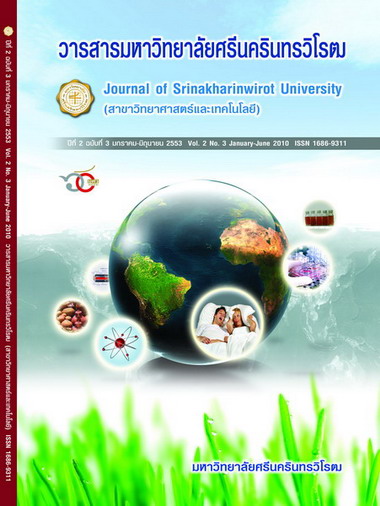การพัฒนาเว็บเพจเพื่อการศึกษา เรื่อง ทฤษฎีอะตอมและคุณสมบัติของสารสำหรับนักเรียนช่วงชั้นที่ 4 (A DEVELOPMENT OF EDUCATIONAL WEB PAGES ON “ATOMIC THEORIES AND PROPERTIES OF SUBSTANCES” FOR THE STUDENTS OF FORTH KEY STAGE)
Keywords:
Educational web-page, Atomic Theories and Properties of substances, Learning outcomes, Attitude Demonstrated, science project presentation abilityAbstract
บทคัดย่อการวิจัยครั้งนี้มีจุดมุ่งหมาย 2 ประการ คือ 1) เพื่อพัฒนาเว็บเพจเพื่อการศึกษา เรื่อง ทฤษฎีอะตอมและคุณสมบัติของสาร สำหรับนักเรียนช่วงชั้นที่ 4 ให้มีประสิทธิภาพตามเกณฑ์ 70/70 และ 2) เพื่อศึกษาผลการเรียนรู้ด้านความรู้ เจตคติของนักเรียนต่อการเรียนด้วยเว็บเพจเพื่อการศึกษา และความสามารถในการนำเสนอผลงานทางวิทยาศาสตร์ โดยการทำแผนที่ความคิด
การพัฒนาเว็บเพจเพื่อการศึกษามีการดำเนินการสร้าง 3 ขั้นตอน คือ 1) การพัฒนาและการประเมินคุณภาพเว็บเพจเพื่อการศึกษาจากผู้เชี่ยวชาญ 2) การหาประสิทธิภาพของเว็บเพจเพื่อการศึกษาโดยการนำไปทดลองวิจัยนำร่องกับนักเรียน จำนวน 3 คน 9 คน และ 15 คน ตามลำดับ และ 3) การนำเว็บเพจเพื่อการศึกษาที่พัฒนาขึ้นไปทดลองสอนกับกลุ่มตัวอย่างเป็นนักเรียนชั้นมัธยมศึกษาปีที่ 4 โรงเรียนราชวินิตบางแคปานขำ กรุงเทพมหานคร จำนวน 30 คน รูปแบบการทดลองที่ใช้ คือ แบบกลุ่มเดียว โดยมีการทดสอบก่อนเรียนและหลังเรียน การวิเคราะห์ข้อมูล กรณีทดสอบก่อนเรียนและหลังเรียน ใช้สถิติ t-test dependent และกรณีการทดลองหลังเรียน ใช้สถิติ t-test one group
ผลการวิจัยพบว่า เว็บเพจเพื่อการศึกษาที่พัฒนาขึ้นมีประสิทธิภาพ 70.55/72.89 ซึ่งสูงกว่าเกณฑ์ที่กำหนด และเมื่อนำไปทดลองสอนพบว่า นักเรียนมีผลการเรียนรู้ด้านความรู้หลังเรียนสูงกว่าก่อนเรียน โดยผลการเรียนรู้ด้านความรู้หลังเรียนได้คะแนนร้อยละ 77.55 ซึ่งสูงกว่าระดับดี มีเจตคติต่อการเรียนด้วย เว็บเพจเพื่อการศึกษาไม่ถึงระดับดี และมีความสามารถในการนำเสนอผลงานทางวิทยาศาสตร์สูงกว่าระดับดี
Abstract This study was conducted under two objectives: 1) to develop an educational web-page on “Atomic Theories and its properties for the forth key-stage students, to reach the 70/70 criterion and 2) to investigate learning outcomes, on knowledge, attitude towards the developed web-page, and science project presentation ability.
The study was accomplished through three stages of operation; 1) development and quality evaluation of the web-page by experts, 2) efficiency identification of the web-page by three consecutive try-outs with three, nine and fifteen students respectively, and 3) instruction experimentation with thirty M.S. IV students of the Rachavinit Bangkhaepankhum school in Bangkok. The experimental design used was the “One-group Pretest-Posttest”. Data were analyzed by the dependent t-test and the one-group t-test for pre and post tests comparisons and for posttest investigation only, respectively.
Findings of the study revealed that efficiency of the developed web-page reached the criterion of 70/70 with corresponding figures of 70.55/72.89 and its instruction experimentation brought about desirable learning outcomes; posttest average score on knowledge designated as “good level” of 77.55 percent which was higher than its pre-test, students had attitude towards the web-page close to the “good” level, and demonstrated science project presentation ability better than the “good” level.
Downloads
Downloads
Published
How to Cite
Issue
Section
License
Srinakharinwirot University Journal of Sciences and Technology is licensed Under a Creative Commons Attribution-NonCommercial-NoDerivs 4.0 International (CC-BY-NC-ND 4.0) License, Unless Otherwise Stated. Please Read Journal Policies Page for More Information on Open Access, Copyright and Permissions.



